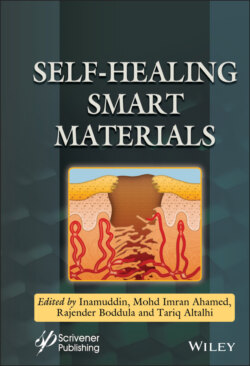Читать книгу Self-Healing Smart Materials - Группа авторов - Страница 21
2.1 Introduction
ОглавлениеAlthough there are many different types of thermosets that were synthesized as high performance polymers during the last century, phenolic resins, as the first man-made plastic, have been continuously used in industry for more than 100 years. As a reflection of this interest, many papers and books were published and conference activities were successfully performed about these resins. The worldwide production of classical phenolic resins, resole and novolac, has reached to a very large volume such as 5 million tons per year and the growth of the production is parallel to the global economic growth rate [1–3]. Definitively, these resins will survive in the second century of their existence due to the interest in global markets. Accordingly, novel applications have already emerged related to phenolic resins such as porous materials by the carbonization of phenolic foams, fiber reinforced phenolics, modern composites for aircrafts, blast protection materials, phenolic resins based adhesives for honeycomb sandwich panels and more [4]. On the other hand, resole and novolac synthesis requires formaldehyde (Scheme 2.1) and the emission problem of this molecule resulted in regulations for phenolic industry. Especially, in wood products formaldehyde residues expose a serious concern of health and environment, therefore, efforts to reduce formaldehyde emissions in these resins is one of the major trend. Moreover, phenolic resins are cured either by using acids or bases before usage and the curing rate of classical phenolic resins are relatively slow compared to other resins and, besides formaldehyde emission, formation of other by-products is a fact during curing [5]. Hence, these problems gave rise to new research and development projects for phenolic resins with the anticipation of more reactivity and less emissions.
Scheme 2.1 Synthesis and representative structures for Novolac and Resole.
The benzoxazine type resins emerged with high potential as a solution for drawbacks of phenolic resins where they have not succeeded sufficiently. Polybenzoxazines (PBZs), a kind of polyaminophenol, are the curing product of 1,3-benzoxazines and are considered as a contender to novolak due to the structural resemblance (Scheme 2.2). Hence, most of the PBZs have properties both similar and also unique that are unseen in novolac resins [6]. They generally exhibit high glass transition temperatures (Tg), char yield, flame resistance, low water absorption, and good mechanical performance [6–12]. In addition, benzoxazines do not exhibit an important shrinkage during curing due to the ring-opening polymerization character [11]. As well known, shrinkage is a problem for many other curable monomer types such as acrylates. Another important superiority of benzoxazines is related to their reactive nature, and thus, by-product release is much lower compared to classical phenolic resins. Typical polymerization of a benzoxazine monomer takes place between 160 and 250 °C without any catalyst or curative (Scheme 2.2) [13–16]. The polymerization of benzoxazines proceed over a cationic ring-opening pathway, and therefore, polymerization temperatures can be reduced by using acidic compounds as catalyst [17–21]. Another advantage of benzoxazine resin chemistry is related to the synthetic simplicity of benzoxazine monomer synthesis. Any phenol and a primary amine, which can tolerate the synthesis conditions, with 2 moles of formaldehyde can yield a benzoxazine monomer (Scheme 2.2) [22–31]. Accordingly, benzoxazine chemistry has a vast design flexibility due to the presence of many different commercially available phenols and amines. The huge molecular diversity of benzoxazines unleashes many possibilities for unconventional uses ranging from self-healing to shape-memory material applications [32].
Scheme 2.2 Synthesis of a 1,3-benzoxazine and production of a polybenzoxazine therefrom.
